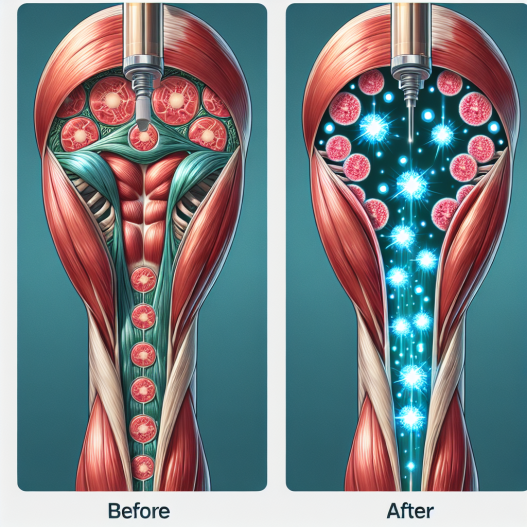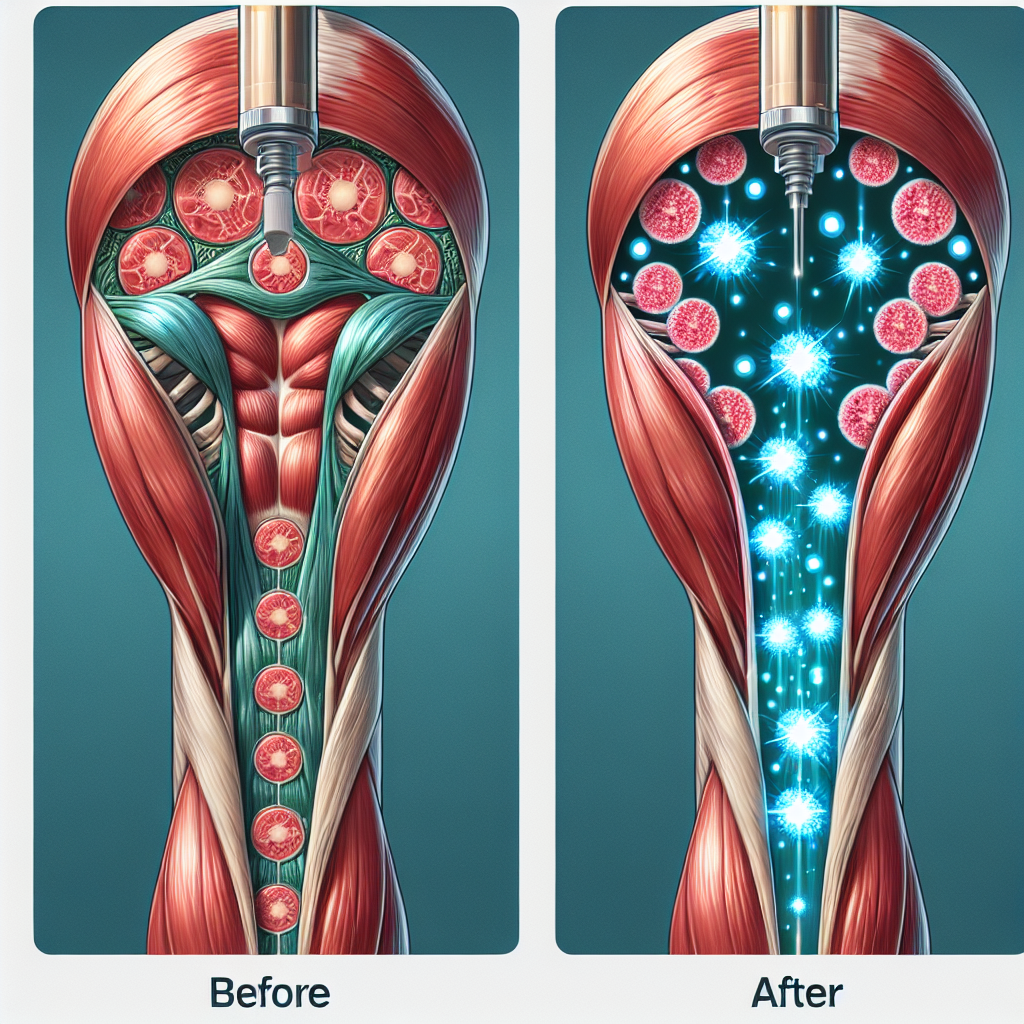-
Table of Contents
«Maximiza tu potencial de recuperación muscular con SARMs»
Introduction
SARMs, or selective androgen receptor modulators, have gained popularity in the fitness and bodybuilding community for their potential to enhance muscle growth and performance. However, one question that often arises is whether SARMs can also improve muscle recovery. In this article, we will explore the potential effects of SARMs on muscle recovery and discuss the current research on this topic.
The Benefits of Using SARMs for Muscle Recovery
SARMs, or Selective Androgen Receptor Modulators, have gained popularity in the fitness world for their potential to enhance muscle growth and improve athletic performance. However, one aspect that is often overlooked is their ability to aid in muscle recovery. In this article, we will explore the benefits of using SARMs for muscle recovery and how they can help individuals reach their fitness goals.
Firstly, it is important to understand the role of muscle recovery in the body. When we engage in physical activity, our muscles undergo stress and micro-tears, which is a normal part of the muscle-building process. However, in order for muscles to grow and become stronger, they need time to repair and recover. This is where SARMs come into play.
SARMs work by binding to androgen receptors in the body, which are responsible for regulating muscle growth and repair. By targeting these receptors, SARMs can help to speed up the recovery process and promote muscle growth. This is especially beneficial for individuals who engage in intense workouts or have a high level of physical activity.
One of the key benefits of using SARMs for muscle recovery is their ability to reduce inflammation. Inflammation is a natural response to muscle damage, but when it becomes chronic, it can hinder the recovery process. SARMs have been shown to have anti-inflammatory properties, which can help to reduce the amount of time it takes for muscles to heal. This means that individuals can get back to their workouts sooner and with less discomfort.
Moreover, SARMs have been found to increase the production of collagen in the body. Collagen is a protein that is essential for maintaining the structural integrity of muscles, tendons, and ligaments. By increasing collagen production, SARMs can help to strengthen and repair damaged muscle tissue, leading to faster recovery times.
In addition to aiding in muscle repair, SARMs can also improve muscle endurance. This is particularly beneficial for athletes or individuals who engage in high-intensity workouts. By increasing muscle endurance, SARMs can help individuals push through their workouts without experiencing fatigue or muscle soreness. This can ultimately lead to better performance and faster progress towards fitness goals.
Another advantage of using SARMs for muscle recovery is their ability to prevent muscle wasting. Muscle wasting, also known as muscle atrophy, occurs when the body breaks down muscle tissue for energy. This can happen during periods of inactivity or when the body is under stress. SARMs have been shown to prevent muscle wasting by promoting muscle growth and repair, making them a valuable tool for individuals looking to maintain their muscle mass.
It is worth noting that while SARMs have shown promising results in aiding muscle recovery, they should not be used as a substitute for proper rest and recovery. Adequate rest and nutrition are still essential for optimal muscle growth and repair. SARMs should be used in conjunction with a healthy lifestyle and training regimen to achieve the best results.
In conclusion, SARMs have numerous benefits when it comes to muscle recovery. From reducing inflammation and increasing collagen production to improving muscle endurance and preventing muscle wasting, SARMs can be a valuable tool for individuals looking to enhance their recovery process. However, it is important to use them responsibly and in accordance with recommended dosages. With proper use, SARMs can help individuals reach their fitness goals and achieve a stronger, healthier body.
Understanding the Science Behind SARMs and Muscle Repair
SARMs, or selective androgen receptor modulators, have gained popularity in the fitness world as a potential alternative to anabolic steroids. These compounds are believed to have similar muscle-building effects without the negative side effects associated with steroids. One of the potential benefits of SARMs that has been widely discussed is their ability to improve muscle recovery. But is there any scientific evidence to support this claim?
To understand the potential of SARMs in muscle recovery, it is important to first understand the science behind muscle repair. When we engage in physical activity, our muscles experience micro-tears, which is a normal part of the muscle-building process. These micro-tears signal the body to repair and rebuild the muscle fibers, resulting in stronger and larger muscles. However, this repair process can take time and can be hindered by factors such as age, diet, and training intensity.
This is where SARMs come into play. These compounds are believed to work by binding to androgen receptors in the body, which are responsible for regulating muscle growth and repair. By selectively targeting these receptors, SARMs are thought to enhance the body’s ability to repair and rebuild muscle tissue, leading to faster recovery times.
While there is limited research on the effects of SARMs on muscle recovery in humans, some studies have shown promising results. One study published in the Journal of Pharmacology and Experimental Therapeutics found that a specific SARM, known as LGD-4033, increased muscle mass and strength in healthy men without causing any adverse side effects. The researchers also noted that the participants experienced faster recovery times after intense exercise.
Another study published in the Journal of Clinical Endocrinology and Metabolism looked at the effects of a different SARM, known as MK-2866, on muscle recovery in elderly men. The results showed that the participants who took MK-2866 had improved muscle strength and physical function compared to those who took a placebo. The researchers also noted that the participants who took MK-2866 had a lower risk of falls and fractures, which can be attributed to improved muscle recovery.
While these studies show promising results, it is important to note that they were conducted on a small number of participants and more research is needed to fully understand the effects of SARMs on muscle recovery. Additionally, the long-term effects of SARMs on the body are still unknown, and there is a lack of regulation and oversight in the production and distribution of these compounds.
It is also worth mentioning that SARMs are not approved by the FDA for human use and are currently only available for research purposes. This means that the quality and purity of these compounds cannot be guaranteed, and there is a risk of purchasing counterfeit or contaminated products.
Furthermore, it is important to note that SARMs are not a magic solution for muscle recovery. Proper nutrition, adequate rest, and a well-designed training program are still the most important factors in promoting muscle repair and growth. SARMs should not be seen as a replacement for these essential components of a healthy lifestyle.
In conclusion, while there is some evidence to suggest that SARMs may improve muscle recovery, more research is needed to fully understand their effects on the body. It is also important to consider the potential risks and lack of regulation surrounding these compounds. As with any supplement, it is always best to consult with a healthcare professional before incorporating SARMs into your fitness routine. Ultimately, a balanced and consistent approach to training and recovery is key to achieving optimal muscle repair and growth.
Maximizing Muscle Recovery with SARMs: Tips and Tricks
SARMs, or selective androgen receptor modulators, have gained popularity in the fitness world for their potential to enhance muscle growth and improve athletic performance. However, one aspect that is often overlooked is their ability to aid in muscle recovery. In this article, we will explore the potential benefits of SARMs in maximizing muscle recovery and provide tips and tricks for incorporating them into your fitness routine.
First, let’s understand what muscle recovery is and why it is important. When we engage in physical activity, our muscles undergo stress and micro-tears, which is a normal part of the muscle-building process. However, in order for our muscles to grow and become stronger, they need time to repair and recover. This is where muscle recovery comes in. It is the process of allowing our muscles to heal and adapt to the stress placed on them during exercise.
SARMs work by binding to androgen receptors in the body, which are responsible for regulating muscle growth and repair. This means that they can potentially aid in the muscle recovery process by promoting protein synthesis and reducing muscle breakdown. Additionally, SARMs have been shown to have anti-inflammatory properties, which can help reduce muscle soreness and inflammation, further aiding in recovery.
One of the most well-known SARMs for muscle recovery is Ostarine. It has been shown to increase muscle mass and strength, while also promoting faster recovery from exercise-induced muscle damage. In a study conducted on healthy men, Ostarine was found to significantly increase lean body mass and improve physical function compared to a placebo group.
Another SARM that has shown promise in aiding muscle recovery is Ligandrol. In a study on elderly men, Ligandrol was found to increase lean body mass and improve physical function, as well as reduce markers of inflammation. This suggests that Ligandrol may have potential benefits for muscle recovery in individuals of all ages.
While SARMs have shown promising results in aiding muscle recovery, it is important to note that they are not a magic solution. Proper nutrition, hydration, and rest are still crucial for optimal muscle recovery. However, incorporating SARMs into your fitness routine may provide an extra boost in the recovery process.
Now, let’s discuss some tips and tricks for incorporating SARMs into your muscle recovery routine. First and foremost, it is important to choose a reputable source for your SARMs. Due to their increasing popularity, there are many counterfeit or low-quality products on the market. Make sure to do your research and purchase from a trusted source to ensure the purity and effectiveness of the product.
Next, it is important to follow the recommended dosage and cycle length for the specific SARM you are using. Taking too much or for too long can lead to negative side effects and may hinder your muscle recovery process. It is also recommended to start with a lower dosage and gradually increase as needed, as everyone’s body reacts differently to SARMs.
In addition to proper dosing, it is important to have a well-rounded fitness routine that includes a mix of resistance training, cardiovascular exercise, and rest days. SARMs can aid in muscle recovery, but they should not be relied upon as the sole method for recovery. Proper nutrition and hydration are also crucial for optimal muscle recovery, so make sure to fuel your body with the necessary nutrients and stay hydrated throughout the day.
In conclusion, while SARMs are primarily known for their muscle-building properties, they can also play a role in aiding muscle recovery. By promoting protein synthesis, reducing inflammation, and improving physical function, SARMs may provide an extra boost in the recovery process. However, it is important to remember that they are not a substitute for proper nutrition, hydration, and rest. By incorporating SARMs into a well-rounded fitness routine, individuals may see improved muscle recovery and overall performance. As always, it is important to consult with a healthcare professional before starting any new supplement regimen.
Q&A
1. ¿Qué son los SARMs?
Los SARMs (Selective Androgen Receptor Modulators) son una clase de compuestos químicos que se unen a los receptores de andrógenos en el cuerpo para estimular el crecimiento muscular y mejorar el rendimiento físico.
2. ¿Pueden los SARMs mejorar la recuperación muscular?
Sí, los SARMs pueden ayudar a mejorar la recuperación muscular al aumentar la síntesis de proteínas y reducir la inflamación en los músculos después del ejercicio intenso. Sin embargo, su uso debe ser supervisado por un profesional de la salud y no se recomienda su consumo sin prescripción médica.
3. ¿Existen riesgos asociados con el uso de SARMs?
Sí, como con cualquier suplemento o medicamento, existen riesgos asociados con el uso de SARMs. Algunos de estos riesgos incluyen daño hepático, cambios en los niveles hormonales y efectos secundarios como acné, calvicie y cambios en la libido. Es importante consultar con un médico antes de tomar cualquier tipo de suplemento o medicamento para mejorar el rendimiento físico.










